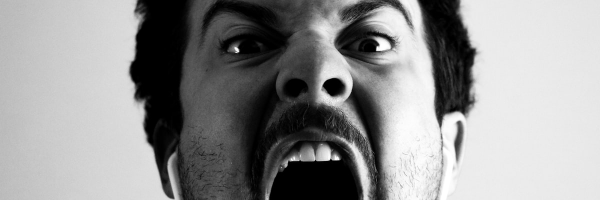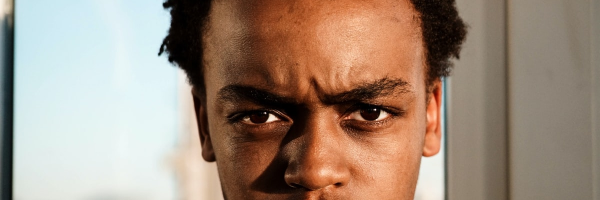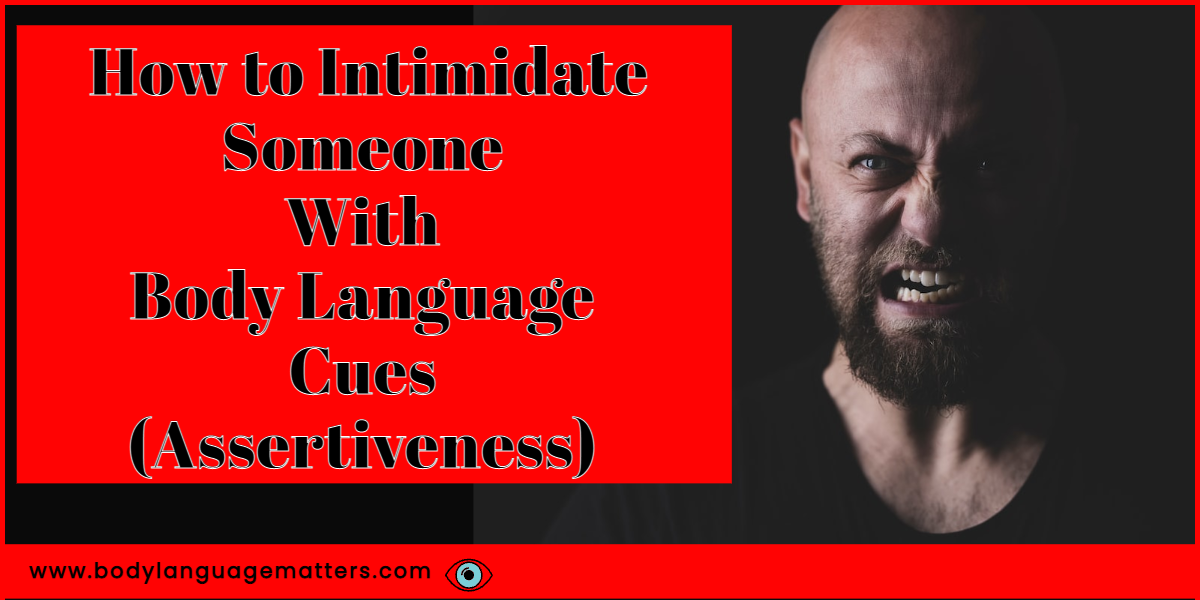There are many reasons why someone can become angry or use aggressive body language towards someone else. If we recognize the signs of hostility and de-escalate the situation, we can avoid a lot of problems in the future.
People often have aggressive body language without realising it. You can usually see the signs if you pay attention to the person’s posture, hand movements, body movement, tone of voice and facial expression. We will take a look at the top 17 aggressive body language cues below.
There are many different types of aggressive body language, such as someone using intimidating touch behavior to threaten another person. They might be aggressive by being physically overly bearing or staring at someone in order to make them feel weak or intimidated.
Aggressive people often show their anger physically and verbally. Aggressive language is used as a way to intimidate another person and force them to back off without raising any objections.
Next, we will take a look at 17 aggressive body language cues you can look out for and recognize before it’s too late.
17 Aggressive Body Language Cues.

Before we get into the cues, it’s important to understand that a nonverbal signal does not mean that someone is becoming aggressive towards us; we have to read clusters of information to learn more about that check out How To Read Body Language & Nonverbal Cues (The Correct Way) but if you don’t have time for that, go with your gut instinct your instincts will guide you when it comes to body language.
There are many types of aggressive body language that are used by people. Some people use the following types of aggressive body language:
- Looking down at their noise.
- Clenched fists.
- Staring.
- Pacing.
- Pointing.
- Slapping hands on thighs.
- Hands-on hips.
- Intimidation.
- Touching or patting other people’s faces or hair.
- Arms of akimbo.
- Hands in pockets.
- Invading personal space.
- Hovering over you when you sitting.
- Blocking your exit.
- Steepling the fingers.
- Pounding of fists on a desk or table.
- Pointing at others aggressively with fingers or an entire hand.
How To Read Aggressive Body Language

There are certain cues that you can use to figure out what an aggressive person is feeling. When reading body language, it’s important to understand the context. For example, if someone is sitting in a chair with their arms crossed, the person might be feeling confident or angry. On the other hand, if someone is sitting in a chair with their arms crossed and they’re leaning forward towards you, this person might be feeling very dominant and aggressive.
We need to take the context into consideration and analyze what is really going on. Consider the conversation you’re in, the environment you’re in, the past behavior of that person and your own bias towards them. Before making any judgements we must first learn to read body language correctly.
How To Deal With Aggressive Body Language

If you find yourself in a situation where someone is exhibiting aggressive body language, the best thing to do is try to stay calm and avoid making any sudden movements. If you can, try to keep your hands visible and open to show that you’re not a threat.
It’s also important to avoid making any direct eye contact, as this can be interpreted as a challenge. If you’re able to diffuse the situation and calm the other person down, that’s ideal. However, if the situation escalates and the other person becomes physically aggressive, it’s important to protect yourself and get away from the situation as quickly as possible.
Remember these ideas.
First of all, we should try to stay calm, and avoid any form of displaying emotions. It is important to remain still and avoid eye contact, as well as not reacting negatively regardless of a situation’s source. This may cause the person to escalate their emotions even more.
It’s also important not to show any signs of fear or weakness which can prompt the person violently trying to intimidate us. To keep your emotions in check, focus on curling your toes inside your shoes this will give your brain something to do and get rid of any excess energy, plus no one will know what you are doing.
It’s important to stay in front of your eyes and not to analyze anything after the fact, stay alert to shifts and movements of the person who is being aggressive. If there are other people around and you feel safe, talk about how the aggressive person is making you feel to them if they can’t hear you. I
If you’re not confident or don’t feel safe, then leave. In general, we should only use our emotions when we know they’ll be positive and influential.
Misinterpretation of Aggressive Body Language

If a person is being assertive and another person interprets their actions as aggressive, this could lead to inaccurate judgments about how hostile or violent the assertive person is. Look for the 17 body language cue above to see if they display a few on them within a short period of time.
Aggressive Body Language In The Workplace
Passive-aggressive behaviors are just one example of non-verbal communication in the workplace which is often present when people want to control or intimidate others.
Examples of aggressive body language:
- Crossing arms across the chest
- Intimidating stares
- Arms folded across the chest
- Leaning towards somebody’s personal space
- Rolling the eyes
- Staring for a prolonged amount of time
When you start to notice this kind of nonverbal directed toward you, it’s time to analyze the situation and take notes on dates, times, and who was around. You could also record the conversation or set up a camera to capture this behavior towards you as an event. Don’t let people intimidate you in the workplace sometimes you have to fight fire with fire.
What is Passive Aggressive Body Language?

It can be really hard to notice passive-aggressive body language, as it is generally subtle and nuanced. Usually, those who are displaying passive-aggressive behaviour are thinking negative thoughts, rather than behaving aggressively towards others.
Fortunately, we can read their body language and adjust the conversation to a more positive outcome or simply choose to leave their presents.
How To Look Aggressive With Body Language

Aggressive body language can be confusing and show mixed messages.
If you intend to use aggressive body language, do so consciously and with caution.
Here are a few things to consider:
- Make direct eye contact
- Clench your fists
- Clenching your jaw
- Take physical space up
- Move slowly an deliberately
- Invade personal space
Security guards and law enforcement might find these tactics useful. We would not recommend using these in the real world, as you could make others feel uncomfortable or confused. Do you want to learn more about body language? How to Intimidate Someone With Body Language Cues (Assertiveness).
Frequently Asked Questions.
how to describe aggressive body language.
When someone is feeling aggressive, their body language will usually reflect that. They may stand with their feet spread apart and their fists clenched, or they may get up close to the person they’re speaking to and invade their personal space. Their voice may also be louder and more forceful than usual.
what is a body language indicator that someone is being aggressive?
One body language indicator that someone is being aggressive is if they are standing up straight with their chest out and their hands on their hips. Another indicator is if they are clenching their fists or pointing their finger at someone. Think police officer or head teacher!
how to tell if someone is angry by body language?
If someone’s body language is closed off, they may be angry. This includes crossed arms and legs, or a furrowed brow. Another way to tell if someone is angry is by their tone of voice; if they’re speaking loudly or quickly, they may be trying to express their anger. Additionally, people who are angry may avoid eye contact or have a clenched jaw. If you’re unsure whether someone is angry, it’s always best to ask them directly.
what is hostile body language?
Hostile body language is typically characterized by tightness in the muscles, furrowed brows, and averted gaze. It can also manifest itself in more overt ways, such as clenched fists or pointed fingers. This type of nonverbal communication conveys aggression and is often used in conjunction with verbal abusive language.
what are some examples of aggressive body language?
Some examples of aggressive body language include glaring, furrowing one’s brows, and clenching one’s fists.
how to look aggressive with body language?
Assuming you want to look aggressive without using any verbal cues, there are several things you can do with your body language. First, take up as much space as possible by spreading your legs and arms out. Second, make sure your posture is powerful and confident–stand up straight, shoulders back, chest out. Third, make eye contact and hold it; don’t blink or look away. Finally, keep your face relaxed but don’t smile–a neutral or slightly angry expression will do.
Final Thoughts.
When it comes to aggressive body language, there are many reasons people use these displays when we learn to recognize them, we can counter their actions before the situation gets out of control. We hope you enjoyed reading this post until next time, have fun!

